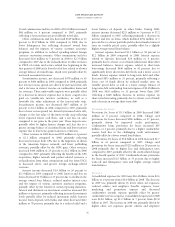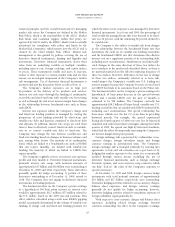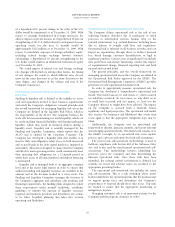American Express 2009 Annual Report Download - page 46
Download and view the complete annual report
Please find page 46 of the 2009 American Express annual report below. You can navigate through the pages in the report by either clicking on the pages listed below, or by using the keyword search tool below to find specific information within the annual report.
2009 FINANCIAL REVIEW
AMERICAN EXPRESS COMPANY
As of December 31, 2009, the Company’s cash and readily-
marketable securities available to fund maturities were as
follows:
(Billions) Total
Cash $19.0(a)
Readily-marketable securities 13.3(b)
Cash and readily marketable securities 32.3
Less:
Operating cash (3.2)(c)
Short-term obligations outstanding (3.2)(d)
Cash and readily-marketable securities available to fund
maturities $25.9
(a) Includes cash and cash equivalents of $15.5 billion and $3.5
billion held in other assets and other receivables on the
Consolidated Balance Sheet for certain forthcoming asset-backed
securitization maturities in the first quarter of 2010.
(b) Consists of certain available-for-sale investment securities (U.S.
Treasury and agency securities, and government-guaranteed debt)
that are considered highly liquid.
(c) Cash on hand for day-to-day operations.
(d) Consists of commercial paper, and U.S. retail CDs with original
maturities of three and six months.
The upcoming approximate maturities of the Company’s
long-term unsecured debt, debt issued in connection with
off-balance sheet securitizations, and long-term customer
deposits are as follows:
(Billions) Debt Maturities
Quarter Ending:
Unsecured
Debt
Asset-Backed
Securitizations
Certificates
of Deposit Total
March 31, 2010 $0.5 $ 4.5 $0.8 $ 5.8
June 30, 2010 2.6 1.8 — 4.4
September 30, 2010 0.9 2.4 0.2 3.5
December 31, 2010 3.4 1.5 1.6 6.5
Total $7.4 $10.2 $2.6 $20.2
The Company’s funding needs for 2010 are expected to arise
from these debt and deposit maturities as well as changes in
business needs, primarily changes in outstanding cardmember
loans and receivables.
The Company considers various factors in determining
the amount of liquidity it maintains, such as economic and
financial market conditions, seasonality in business
operations, growth in its businesses, the cost and availability
of alternative liquidity sources, and regulatory and Credit
Rating Agency considerations.
The yield the Company receives on its cash and readily-
marketable securities is, generally, less than the interest
expense on the sources of funding for these balances. Thus,
the Company incurs substantial net interest costs on these
amounts. The level of net interest costs will be dependent on
the size of its cash and readily-marketable securities holdings,
as well as the difference between its cost of funding these
amounts and their investment yields.
Cash and Readily-Marketable Securities
As of December 31, 2009, the Company held, as part of its
contingent liquidity plan, a total of $19.0 billion of short-term
instruments and $13.3 billion of longer-term readily-
marketable securities. These investments are of high credit
quality, highly liquid short-term instruments and longer-
term, highly liquid instruments, such as U.S. Treasury
securities, government-sponsored entity debt, or government-
guaranteed debt. These instruments are managed to either
mature prior to the maturity of borrowings that will occur
within the next 12 months, or are sufficiently liquid that the
Company can sell them or enter into sale/repurchase
agreements to immediately raise cash proceeds to meet
liquidity needs.
Federal Reserve Discount Window
The Banks are insured depository institutions that have the
capability of borrowing from the Federal Reserve Bank of San
Francisco, subject to the amount of qualifying collateral that
they pledge. The Banks are approved to access the discount
window, subject to the discretion of the Federal Reserve Bank
of San Francisco and sufficient credit and charge card
receivables pledged as collateral, thereby providing them with
an additional source of liquidity, if needed.
The Company had approximately $33.2 billion as of
December 31, 2009, in U.S. credit card loans and charge card
receivables that could be sold over time through its existing
securitization trusts, or pledged in return for secured
borrowings to provide further liquidity, subject in each case to
applicable market conditions and eligibility criteria.
Committed Bank Credit Facilities
The Company maintained committed bank credit facilities
as of December 31, 2009 as follows:
(Billions)
Parent
Company Credco
Centurion
Bank FSB Total
Committed(a) $1.3 $10.1 $0.4 $0.4 $12.2
Outstanding $ — $ 3.2 $ — $ — $ 3.2
(a) Committed lines were supplied by 34 financial institutions as of
year end. However, effective January 20, 2010, the agreements in
which Aurora Bank FSB (previously Lehman Brothers Bank FSB)
participated, were amended, and their participation waived. This
reduced the total committed lines by $175 million.
44
























